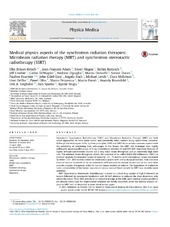| dc.contributor.author | Bräuer-Krisch, Elke | |
| dc.contributor.author | Adam, Jean-Francois | |
| dc.contributor.author | Alagoz, Enver | |
| dc.contributor.author | Bartzsch, Stefan | |
| dc.contributor.author | Crosbie, Jeff | |
| dc.contributor.author | DeWagter, Carlos | |
| dc.contributor.author | Dipuglia, Andrew | |
| dc.contributor.author | Donzelli, Mattia | |
| dc.contributor.author | Doran, Simon | |
| dc.contributor.author | Fournier, Pauline | |
| dc.contributor.author | Kalef-Ezra, John | |
| dc.contributor.author | Kok, Angela | |
| dc.contributor.author | Lerch, Michael L.F. | |
| dc.contributor.author | McErlean, Ciara | |
| dc.contributor.author | Oelfke, Uwe | |
| dc.contributor.author | Olko, Pawel | |
| dc.contributor.author | Petasecca, Marco | |
| dc.contributor.author | Povoli, Marco | |
| dc.contributor.author | Rosenfeld, Anatoly B. | |
| dc.contributor.author | Siegbahn, Erik A. | |
| dc.contributor.author | Sporea, Dan | |
| dc.contributor.author | Stugu, Bjarne | |
| dc.date.accessioned | 2016-03-04T10:15:00Z | |
| dc.date.available | 2016-03-04T10:15:00Z | |
| dc.date.issued | 2015-09 | |
| dc.Published | Physica medica (Testo stampato) 2015, 31(6):568-583 | eng |
| dc.identifier.issn | 1724-191X | en_US |
| dc.identifier.uri | https://hdl.handle.net/1956/11434 | |
| dc.description.abstract | Stereotactic Synchrotron Radiotherapy (SSRT) and Microbeam Radiation Therapy (MRT) are both novel approaches to treat brain tumor and potentially other tumors using synchrotron radiation. Although the techniques differ by their principles, SSRT and MRT share certain common aspects with the possibility of combining their advantages in the future. For MRT, the technique uses highly collimated, quasi-parallel arrays of X-ray microbeams between 50 and 600 keV. Important features of highly brilliant Synchrotron sources are a very small beam divergence and an extremely high dose rate. The minimal beam divergence allows the insertion of so called Multi Slit Collimators (MSC) to produce spatially fractionated beams of typically ∼25–75 micron-wide microplanar beams separated by wider (100–400 microns center-to-center(ctc)) spaces with a very sharp penumbra. Peak entrance doses of several hundreds of Gy are extremely well tolerated by normal tissues and at the same time provide a higher therapeutic index for various tumor models in rodents. The hypothesis of a selective radio-vulnerability of the tumor vasculature versus normal blood vessels by MRT was recently more solidified. SSRT (Synchrotron Stereotactic Radiotherapy) is based on a local drug uptake of high-Z elements in tumors followed by stereotactic irradiation with 80 keV photons to enhance the dose deposition only within the tumor. With SSRT already in its clinical trial stage at the ESRF, most medical physics problems are already solved and the implemented solutions are briefly described, while the medical physics aspects in MRT will be discussed in more detail in this paper. | en_US |
| dc.language.iso | eng | eng |
| dc.publisher | Elsevier | en_US |
| dc.rights | Attribution CC BY-NC-ND | eng |
| dc.rights.uri | http://creativecommons.org/licenses/by-nc-nd/4.0/ | eng |
| dc.subject | Microbeam radiation therapy | eng |
| dc.subject | SSRT | eng |
| dc.subject | Monte Carlo calculations | eng |
| dc.subject | MRT | eng |
| dc.subject | Radiation oncology | eng |
| dc.subject | Synchrotron X-rays | eng |
| dc.subject | Dosimetry | eng |
| dc.title | Medical physics aspects of the synchrotron radiation therapies: Microbeam radiation therapy (MRT) and synchrotron stereotactic radiotherapy (SSRT) | en_US |
| dc.type | Peer reviewed | |
| dc.type | Journal article | |
| dc.date.updated | 2015-12-29T14:00:24Z | |
| dc.description.version | publishedVersion | en_US |
| dc.rights.holder | Copyright 2016 Elsevier | en_US |
| dc.identifier.doi | https://doi.org/10.1016/j.ejmp.2015.04.016 | |
| dc.identifier.cristin | 1276170 | |
| dc.relation.project | Norges forskningsråd: 219991 | |

